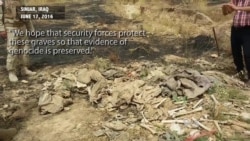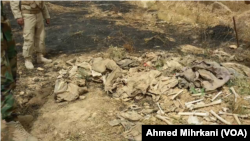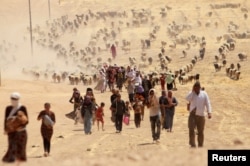Yazidi mass grave sites in northern Iraq that provide evidence of possible Islamic State genocide are being neglected and face a serious threat of disappearing, Yazidi support groups have told VOA.
The issue caught the attention of the rights groups after a fire broke out around a mass grave in Sinjar, Iraq earlier this month. This site is believed to contain the remains of Yazidi members massacred by IS two years ago. Kurdish officials said their forces controlled the fire before it reached the human remains, but concern among the Yazidi community grew over the damage to the site.
Earlier this year, Human Rights Watch asked Iraqi and Kurdish authorities to protect the gravesites. The group asked international experts and donors to help finance the preservation of the sites.
“Justice for the Yazidi victims of the mass killings by ISIS depends on preservation of the Mount Sinjar gravesites,” a statement from the group’s Deputy Middle East Director Joe Stork read. “Kurdish authorities should protect the evidence at these sites and shield them from further degradation by weather and animals.”
Yazidi support groups say sites remain unprotected, months after IS was removed from the area.
Bones spread about
According to the groups, bones can be seen spread around the mass graves, which have been degraded by weather, people and animals. In some areas, human remains removed by animals can be found kilometers away from the grave sites, according to the support groups.
“It is very painful for Yazidi people to see this happening,” said Mirza Dinnayi, a Yazidi and the head of a German-based organization to treat Iraqi children and terror victims called Air Bridge Iraq.
“When IS killed these people, it didn’t bother to bury them properly,” he said. “Most of them are covered with only a thin layer of dirt, which is easy to remove.”
Dinnayi, who recently visited the sites, told VOA that 25 mass graves containing the bodies of hundreds of Yazidis in Sinjar have been abandoned, with little or no protection by authorities in Iraq. He said that in some cases, local residents or the authorities removed the human remains, believing they could identify the victims, or handed them over to the families for burial.
Dinnayi said urgent action is required from the Kurdish government and international community before the gravesites are unrecoverable.
But the Kurdistan Regional Government says it is facing a severe financial crisis and lacks the expertise needed to preserve the mass graves,” Dinnayi told VOA. “And international organizations want to get paid to work in these areas.”
Money shortage
Kurdish officials say their forces are protecting the sites where IS is no longer in control, but security and financial crises are hindering their efforts.
“Some of the grave sites are only two or three miles away from IS and are easy for militants to target,” Hussein Qasim Hasun, a Yazidi member of the Kurdish government’s Higher Governmental Commission on Recognition of Genocide against Yazidis and Other Minorities, and an adviser to Kurdish Prime Minister Nechirvan Barzani, told VOA. “I was targeted by IS rockets three times in those gravesites.”
Hasun said his team has visited the burned site around the mass grave in Sinjar and, as a preliminary action, has used a bulldozer to remove the bushes around the grave site to prevent fire reaching the remains.
“This incident was a wakeup call for our commission and the government to act urgently,” he said. “These graves have been out there for a while and many remains are lost due to rain, summer heat and animals.”
“In some places, our team has found bones 100 meters to 200 meters away from the grave sites, which are believed to be removed by dogs.”
Preservation effort
Hasun explained that his commission has been working with international organizations to help train a team of Kurds on how to preserve the grave sites. But he argued it is expensive and time consuming for his government to prepare a team of experts in compliance with international standards.
Hasun told VOA his commission has decided to collect the bones and remains on the ground, and fence the grave sites that are uncovered after the month of Ramadan.













